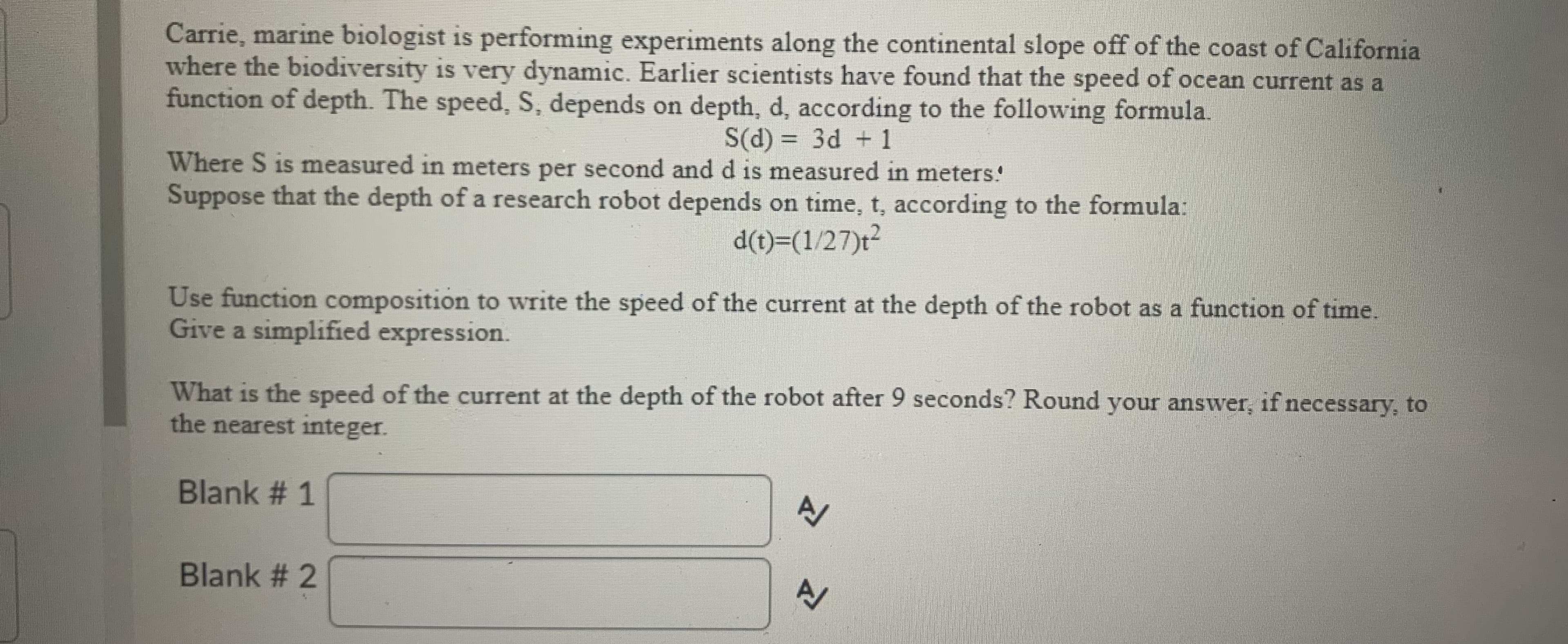Carrie, marine biologist is performing experiments along the continental slope off of the coast of California where the biodiversity is very dynamic. Earlier scientists have found that the speed of ocean current as a function of depth. The speed, S, depends on depth, d, according to the following formula. S(d) = 3d +1 %3D Where S is measured in meters per second and d is measured in meters! Suppose that the depth of a research robot depends on time, t, according to the formula: d(t)=(1/27)t² Use function composition to write the speed of the current at the depth of the robot as a function of time. Give a simplified expression. What is the speed of the current at the depth of the robot after 9 seconds? Round your answer, if necessary, to the nearest integer. Blank # 1 Blank # 2
Carrie, marine biologist is performing experiments along the continental slope off of the coast of California where the biodiversity is very dynamic. Earlier scientists have found that the speed of ocean current as a function of depth. The speed, S, depends on depth, d, according to the following formula. S(d) = 3d +1 %3D Where S is measured in meters per second and d is measured in meters! Suppose that the depth of a research robot depends on time, t, according to the formula: d(t)=(1/27)t² Use function composition to write the speed of the current at the depth of the robot as a function of time. Give a simplified expression. What is the speed of the current at the depth of the robot after 9 seconds? Round your answer, if necessary, to the nearest integer. Blank # 1 Blank # 2
Glencoe Algebra 1, Student Edition, 9780079039897, 0079039898, 2018
18th Edition
ISBN:9780079039897
Author:Carter
Publisher:Carter
Chapter6: Systems Of Linear Equations And Inequalities
Section6.1: Graphing Systems Of Equations
Problem 57PFA
Related questions
Question

Transcribed Image Text:Carrie, marine biologist is performing experiments along the continental slope off of the coast of California
where the biodiversity is very dynamic. Earlier scientists have found that the speed of ocean current as a
function of depth. The speed, S, depends on depth, d, according to the following formula.
S(d) = 3d +1
%3D
Where S is measured in meters per second and d is measured in meters!
Suppose that the depth of a research robot depends on time, t, according to the formula:
d(t)=(1/27)t²
Use function composition to write the speed of the current at the depth of the robot as a function of time.
Give a simplified expression.
What is the speed of the current at the depth of the robot after 9 seconds? Round your answer, if necessary, to
the nearest integer.
Blank # 1
Blank # 2
Expert Solution
This question has been solved!
Explore an expertly crafted, step-by-step solution for a thorough understanding of key concepts.
This is a popular solution!
Trending now
This is a popular solution!
Step by step
Solved in 2 steps with 3 images

Recommended textbooks for you

Glencoe Algebra 1, Student Edition, 9780079039897…
Algebra
ISBN:
9780079039897
Author:
Carter
Publisher:
McGraw Hill

Algebra and Trigonometry (MindTap Course List)
Algebra
ISBN:
9781305071742
Author:
James Stewart, Lothar Redlin, Saleem Watson
Publisher:
Cengage Learning

College Algebra
Algebra
ISBN:
9781305115545
Author:
James Stewart, Lothar Redlin, Saleem Watson
Publisher:
Cengage Learning

Glencoe Algebra 1, Student Edition, 9780079039897…
Algebra
ISBN:
9780079039897
Author:
Carter
Publisher:
McGraw Hill

Algebra and Trigonometry (MindTap Course List)
Algebra
ISBN:
9781305071742
Author:
James Stewart, Lothar Redlin, Saleem Watson
Publisher:
Cengage Learning

College Algebra
Algebra
ISBN:
9781305115545
Author:
James Stewart, Lothar Redlin, Saleem Watson
Publisher:
Cengage Learning

Algebra & Trigonometry with Analytic Geometry
Algebra
ISBN:
9781133382119
Author:
Swokowski
Publisher:
Cengage

Algebra for College Students
Algebra
ISBN:
9781285195780
Author:
Jerome E. Kaufmann, Karen L. Schwitters
Publisher:
Cengage Learning
